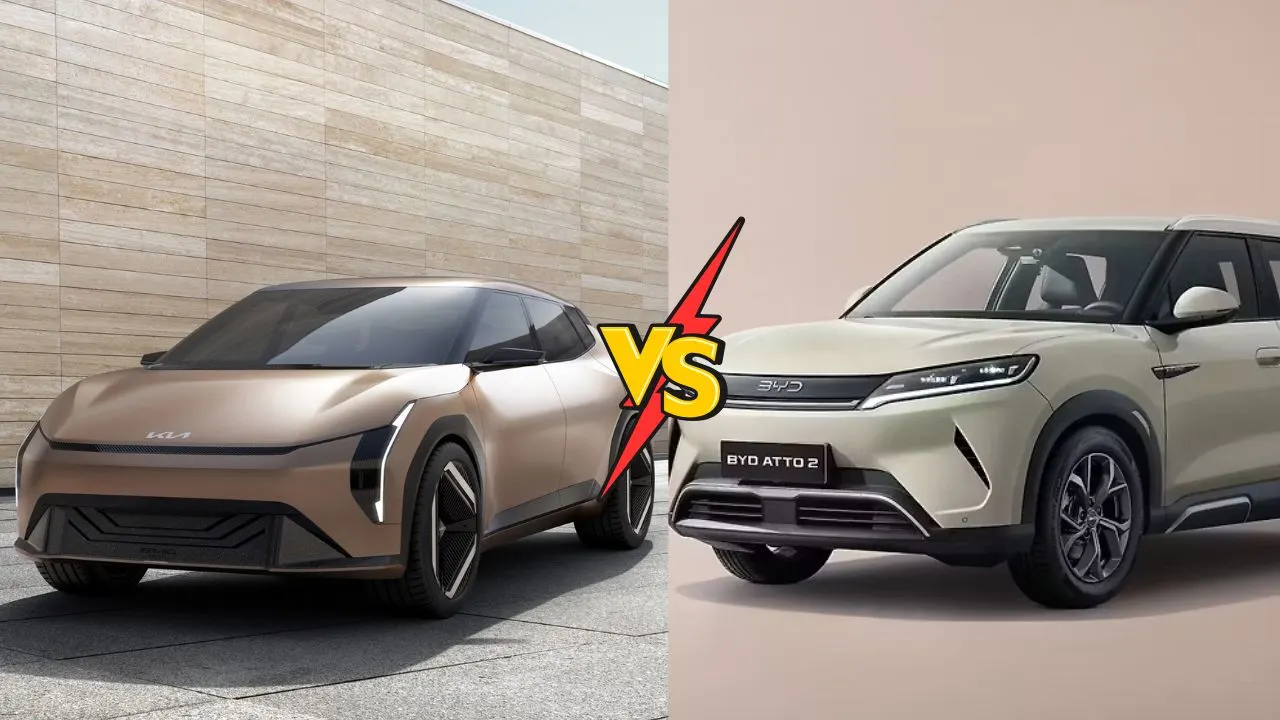The electric vehicle (EV) market in Australia is heating up, with Chinese automaker BYD leading the charge by introducing its most affordable electric SUV yet, the 2026 BYD Atto 2. Confirmed for an Australian release in the fourth quarter of 2025 (October–December), the Atto 2 is poised to take on the newly launched Kia EV3, offering a compelling blend of affordability, technology, and practicality. As BYD continues its rapid expansion in Australia, the Atto 2 aims to capture the attention of urban drivers seeking a compact, budget-friendly EV without compromising on modern features. This article explores the Atto 2’s specifications, pricing, features, and how it stacks up against the Kia EV3, providing a comprehensive guide for prospective buyers.
BYD Atto 2: Overview and Australian Launch
The BYD Atto 2 is a compact, fully electric SUV built on BYD’s e-Platform 3.0, the same architecture underpinning the popular Atto 3 and Dolphin models. Designed to slot below the Atto 3 in size and price, the Atto 2 targets cost-conscious buyers looking for an urban-friendly EV with a competitive edge. According to industry reports, the Atto 2 will arrive in Australian showrooms in late 2025, with a projected starting price of around $35,000 before on-road costs, making it one of the most affordable electric SUVs in the market. This strategic pricing positions it as a direct rival to the Kia EV3, which starts at $47,600 before on-roads, and other competitors like the Hyundai Kona Electric and MG S5 EV.
BYD’s Australian distributor, EVDirect, has not yet finalized the Atto 2’s local name or exact pricing, but CEO David Smitherman hinted at plans for “smaller SUVs” in late 2024, effectively confirming the model’s arrival. The Atto 2 name is likely to be retained in Australia, given its fit within BYD’s lineup, sitting below the Atto 3 ($39,990–$44,990) and above the Dolphin hatchback ($29,990–$36,990). The vehicle’s launch comes as BYD transitions to a factory-backed distribution model in Australia, cutting ties with EVDirect to enhance aftersales support and market presence.
Specifications and Performance
The Atto 2 is powered by a single front-mounted electric motor delivering 130kW of power and 290Nm of torque, achieving a 0–100km/h sprint in a claimed 7.9 seconds. While this performance is modest compared to the Kia EV3’s 150kW/283Nm motor (0–100km/h in 7.5 seconds), the Atto 2’s focus is on efficiency and affordability rather than outright speed. It features a 51kWh lithium-iron-phosphate (LFP) “Blade” battery, offering a WLTP-rated driving range of approximately 312km. In contrast, the Kia EV3’s Standard Range variant boasts a 58.3kWh battery with a 436km range, while its Long Range model extends to 604km with an 81.4kWh battery.
The Atto 2 supports 65kW DC fast charging, allowing a 30–80% charge in about 28 minutes, and 11kW AC charging for home use. It also includes vehicle-to-load (V2L) capability, enabling the battery to power external devices via the charge port—a feature shared with the EV3. The Atto 2’s e-Platform 3.0 incorporates cell-to-body battery construction, enhancing body stiffness and safety, which could give it an edge in crash protection, though it awaits ANCAP or Euro NCAP testing.
Dimensionally, the Atto 2 measures 4310mm long, 1830mm wide, and 1675mm tall, with a 2620mm wheelbase—almost identical to the Kia EV3 (4300mm long, 1850mm wide, 1570mm tall, 2680mm wheelbase). Its 400L boot expands to 1340L with the rear seats folded, slightly trailing the EV3’s 460L/1400L capacity. The Atto 2’s compact size makes it ideal for city driving, with super-light steering noted for easy urban navigation, though its handling is less dynamic than the EV3’s, with some body roll in corners.
Interior and Technology
The Atto 2’s interior is a standout, offering a premium feel for its price point. It features vegan leather (high-quality vinyl) upholstery, soft-touch materials, and comfortable high-backed bucket seats. The cabin includes a 10.1-inch rotatable touchscreen infotainment system on Essential (Dynamic) trims, upgrading to 12.8 inches on Premium models, paired with an 8.8-inch digital driver display. Other tech highlights include a 50W vented wireless phone charger, Bluetooth digital key, and a six-speaker audio system. However, the reliance on touchscreen climate controls may frustrate some drivers.
In comparison, the Kia EV3 offers twin 12.3-inch screens for infotainment and driver information, plus a 5.3-inch climate control screen, with wireless Apple CarPlay, Android Auto, and a smart tailgate on higher trims. The EV3’s GT-Line variant adds a head-up display and an eight-speaker Harman Kardon sound system, giving it a slight edge in tech sophistication. However, the Atto 2’s interior is praised for its upmarket ambiance, potentially outshining budget rivals like the Opel Frontera and Citroen C3 Aircross.
Safety features on Australian Atto 2 models include adaptive cruise control, six airbags, and a reversing camera (upgraded to a 360-degree camera on Premium trims). Overseas models offer blind-spot detection, driver monitoring, and autonomous emergency braking, but their inclusion in Australia is unconfirmed. The Kia EV3, meanwhile, comes standard with a comprehensive suite, including blind-spot monitoring, lane-keep assist, and rear cross-traffic alert, potentially giving it an advantage in safety credentials.
Pricing and Market Positioning
The Atto 2’s estimated starting price of $35,000–$40,990 before on-roads undercuts the Kia EV3’s $47,600–$63,950 range, positioning it closer to the BYD Dolphin and MG4 ($37,990 drive-away). This price advantage could make the Atto 2 a game-changer in Australia’s EV market, appealing to budget-conscious buyers seeking SUV practicality. The Atto 3, starting at $39,990, and the Hyundai Kona Electric ($54,000) are pricier, while the MG S5 EV, another Atto 3 rival, starts around $40,000. The Atto 2’s pricing strategy avoids cannibalizing sales of its siblings while offering a compelling alternative to traditional petrol SUVs like the Toyota Yaris Cross.
The Kia EV3, built on a 400V version of Hyundai’s E-GMP platform, targets buyers willing to pay a premium for longer range and advanced features. Its Standard Range Air model ($47,600) and Long Range GT-Line ($63,950) cater to different budgets, but the Atto 2’s lower entry point and comparable size make it a strong value proposition. The Atto 2’s Essential and Premium trims (equivalent to Dynamic and Premium in some markets) offer flexibility, with the Premium grade adding features like a larger touchscreen and surround-view camera.
Competitive Landscape
The Atto 2 enters a crowded compact EV SUV segment, with the Kia EV3 as its primary rival. The EV3’s strengths include a longer driving range (up to 604km), faster charging (150kW DC), and a more polished driving experience, thanks to its i-Pedal 3.0 regenerative braking system. However, its higher price and less spacious rear seating may deter some buyers. The Atto 2 counters with a lower cost, a premium interior, and sufficient range for urban commuters, though its 312km range and slower charging may limit its appeal for long-distance drivers.
Other competitors include:
-
Hyundai Kona Electric ($54,000+): Offers a 400km+ range but is pricier and less feature-rich than the EV3.
-
MG S5 EV ($40,000+): A close rival to the Atto 2 with a 425km range, but its brand perception may trail BYD’s growing reputation.
-
Volvo EX30: A premium option with a higher price point, targeting luxury buyers.
-
GWM Ora: A smaller hatchback with a lower price but less SUV practicality.
BYD’s aggressive expansion, including models like the Sealion 6, Sealion 7, and Shark 6 ute, underscores its ambition to dominate Australia’s EV market. The Atto 2’s launch aligns with this strategy, offering a “cheap, cheerful” option that could replicate the Atto 3’s success.
Driving Experience and Practicality
Early reviews of the Atto 2, based on test drives in China, highlight its urban-friendly handling, with light steering ideal for tight city streets. However, its steering lacks feedback, and the suspension shows some body roll, making it less engaging than the EV3, which offers sharper handling and adjustable regenerative braking. The Atto 2’s chassis benefits from its lightweight 1570kg construction, providing decent bump absorption and cabin noise suppression. Its spacious interior, with ample legroom and headroom, rivals the EV3, though its boot capacity is slightly smaller.
For families, the Atto 2’s 400L boot and 60:40 split-fold rear seats offer practical storage, while its V2L capability adds versatility for camping or outdoor activities. The EV3’s larger boot and frunk (25L under-bonnet storage) give it a slight edge for cargo, but the Atto 2’s lower price and premium interior materials may sway budget-conscious families.
Market Impact and Consumer Appeal
The Atto 2’s arrival is timely, as Australia’s EV market grows amid rising fuel costs and stricter emissions regulations. BYD’s focus on affordability aligns with consumer demand for accessible EVs, with the Atto 2 potentially undercutting the EV3 by $10,000 or more. Its combination of price, space, and tech could make it a “bargain smash hit,” especially among urban buyers who prioritize value over long-range capability. The Atto 2’s untested ANCAP rating is a potential concern, particularly if it lacks a front-center airbag, but BYD’s e-Platform 3.0 suggests strong safety potential.
The Kia EV3, while more expensive, appeals to buyers seeking a premium driving experience and longer range, backed by Kia’s established aftersales network. BYD’s shift to factory-backed distribution could close this gap, enhancing service quality and consumer confidence. Posts on X reflect excitement for the Atto 2, with users praising its sleek design and tech features, though some note its range limitations compared to the EV3.
Looking Forward
The 2026 BYD Atto 2 is set to shake up Australia’s compact EV SUV market, offering a budget-friendly alternative to the Kia EV3 with a starting price around $35,000. Its premium interior, practical design, and V2L capability make it a strong contender for urban drivers, despite its shorter range and less dynamic handling. The Kia EV3 counters with superior range, faster charging, and advanced safety features, but its higher price may deter cost-sensitive buyers. As BYD expands its Australian presence, the Atto 2 could become a top seller, building on the success of the Atto 3 and Dolphin. Prospective buyers should monitor pricing announcements and test drives in late 2025 to make an informed choice in this competitive segment.

